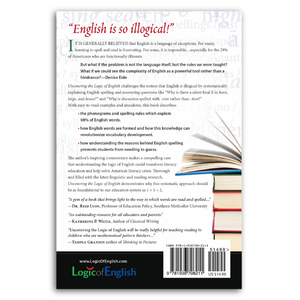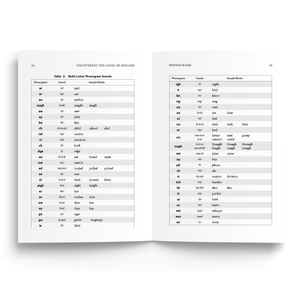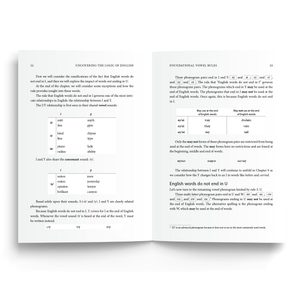There is a widespread misconception that English is illogical — that there are too many exceptions to every rule. English is often considered one of the most complicated languages to learn. But is English really illogical? Or are we simply missing something vital to unlocking our understanding?
Sometimes, commonly taught phonograms and spelling rules can cause more confusion than clarity. Let’s take a look at a few examples.
Commonly Taught Phonograms
Most people know the 26 letters, but what about the 75 phonograms? English is made up of letter-sound correspondences, otherwise known as phonograms. Letter-sound correspondences help us decode and read words fluently, including high-frequency words. A phonogram, literally speaking, is a picture of a sound. Each phonogram is a letter or combination of letters, such as m, e, tch, or ou, representing a phoneme or sound in English. Knowing the phonograms is vital to learning how to decode written English.
phono + gram
phono — Greek for "sound"
gram — from Greek for a letter or something written
We are often taught an incomplete picture of phonograms — leaving us to believe English is a language made up of exceptions. According to research, of the 150 most frequently used words in English textbooks, only 23% are decodable using common letter-sound correspondences (Adams, 1994).

For example, students are often taught that S says /s/, which is true 57% of the time, according to Phinder, but S also says /z/ 43% of the time (Kearns, 2023)! If a letter makes a sound 43% of the time, is that really an exception? When we teach a more complete set of letter-sound correspondences (like S says /s/ AND /z/), we are able to see that true exceptions are less common than we were previously taught.
Learning all the sounds for each phonogram right from the beginning helps to prevent confusion, teaches the students there is a pattern to the language and eliminates unnecessary exceptions. These 75 Basic Phonograms combined with the 31 spelling rules explain 98% of English words.
Commonly Taught Spelling Rules
Some of the most commonly taught spelling rules paint an incomplete picture of the English language, causing confusion and misunderstanding of spelling rules. For example, “I before E except after C” doesn’t always work. The rule applies to many words, except for efficiency, science, vein, seize, height, etc.
Instead of teaching this spelling rule, knowing the sounds of the phonograms EI and IE is more effective and helps to prevent exceptions.
Logic of English teaches the phonogram EI as having three sounds: long /ā/ as in beige, long /ē/ as in protein, and long /ī/ as in feisty. There are only a limited number of words that use the EI phonogram, and many of these words are more advanced vocabulary.



Depending on the dialect, ei will represent /ē/ or /ī/ in the pronunciations of neither, either, and Holstein.

Commonly Taught Silent E Rules
“Silent E makes the vowel say its name” is one of the most commonly taught spelling rules. This rule is commonly called the “magic e” rule because the e gives all its power to the other vowel. However, when this is the only rule that we are taught, it leaves hundreds of words as exceptions! Here are just a few examples:
- Give
- Live
- Have
- Above
- Puddle
- Love
- Horse
There are actually nine reasons for Silent E:
Silent Final E Rules:

1: The vowel says its long sound because of the E.
2: English words do not end in V or U.
3: The C says /s/ and the G says /j/ because of the E.
4: Every syllable must have a written vowel.
5: Add an E to keep singular words that end in the letter S from looking plural.
6: Add an E to make the word look bigger.
7: TH says its voiced sound /TH/ because of the E.
8: Add an E to clarify meaning.
9: Unseen reason.
Instead of relying on a few spelling rules, it’s important to teach all of them. Teaching all thirty-one spelling rules gives a complete picture of spelling — significantly reducing the number of exceptions (and headaches).
English is Complex, But Logical
The widespread assumption is that English is illogical. In reality, the logic of the written patterns of English has been lost in the past 80 years.
Language experts have found that a majority of children who are presented with the whole picture of English, combined with solid methods, can succeed. Instead of presenting a language riddled with exceptions, we can provide a more complete picture for our students. After all, it is a complex code. Why would we abandon our young students to solve a master puzzle like English on their own? (Eide, 2012).
Learning a more complete set of basic phonograms and learning accurate spelling rules is the most efficient route to mastering English. Instead of leaving so many exceptions, we have the tools to decode 98% of English words.
With a more complete set of phonics rules, including 75 basic phonograms and 31 spelling rules, we can rediscover the logical nature of English.
References
Adams, M. J. (1994). Beginning to read: Thinking and learning about print. Bradford Books.
Eide, D. (2012). Uncovering the logic of English : a common-sense approach to reading, spelling, and literacy. Logic of English Inc.
Kearns, D. (2023). PHINDER. https://devinkearns.com/phinder/












